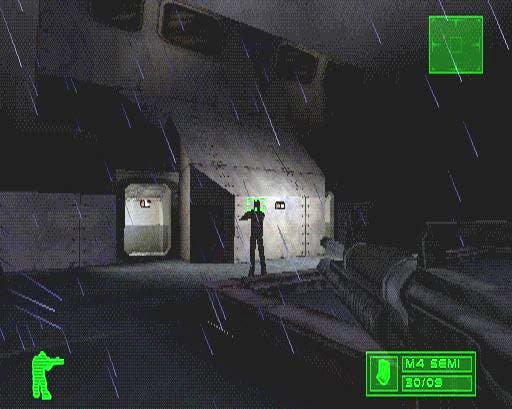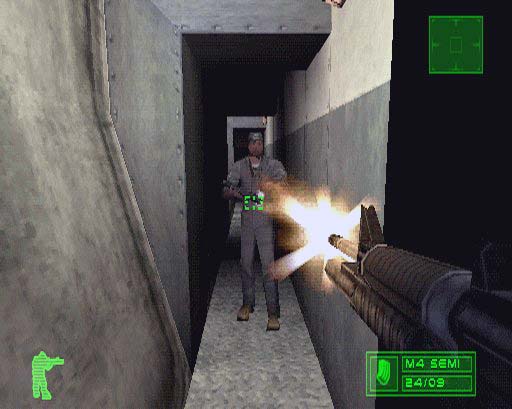Delta Force: Urban Warfare
Review - Sony's veteran console goes back into action one last time

Dads Army
Before Delta Force: Urban Warfare landed on my doormat, I couldn't remember the last time I'd even turned my PlayStation on. In fact, I had to rummage about in the back of a cupboard to find it, blowing away the dust like it was some wizened old book. I plugged it into the TV, popped the disc in the drive, pressed the power button and .. nothing happened. Obviously my PSX has given up the ghost while its younger sibling was attracting all the attention. Which is a shame, because Rebellion were willing to give it a decent workout with their PlayStation exclusive Delta Force shooter. And what a workout it is - the poor old thing hasn't seen action like this for years.
Luckily then a standby was available in the form of the PS2's back-compatibility. It's obvious from the outset that Rebellion have spent an astonishing amount of time optimising and re-optimising the code behind Urban Warfare, as the first engine-rendered cutscene details the start of the game's story. The proceedings open with a drugs bust in Mexico by a Delta Force team led by John Carter, our protagonist. Things all seem to be quite straightforward until he witnesses his team wiped out in a ball of flames; apparently someone knew they were coming.
Cue our John going off on a lone gunman crusade against the terrorist organisation who disposed of his pals, all the while attempting to expose a mole in the CIA and find out exactly why all this is going on. So what appears at first to be a perfect opportunity to be a gritty narrative-driven stealth fest actually boils down to a bog standard first person shooter with smatterings of sneaking about here and there. Damn.

Money For Old Rope
It's easy to be completely disgusted by the ropey graphics and character models at first, and I kept having to remind myself of the hardware I was playing on (or would have been playing on, had it worked). However, despite the obvious limitations Rebellion have done a sterling job of constructing a fairly varied and engrossing world with plenty of detail and atmosphere. They've even gone so far as to have a decent stab at facial animation, although their effort at lip-synching leaves a great deal to be desired.
It doesn't take long before you get used to the dodgy visuals though, and once you actually get stuck into the action it's almost as if the PS2 never happened. The progression of the game is strictly linear and played on a mission-by-mission basis, and while the variety is quite satisfying it's completely predictable across the disappointingly slight twelve missions.
Fairly well directed in-game cutscenes separate each level and progress the story, and this is where some of the game's better voice talent and excellent sound design gets a chance to really shine. We start out with an ordinary assault on a warehouse in Mexico, battling our way through a band of miscellaneous goons in order to reach their boss and question him. This is the sort of scenario that Urban Warfare is primarily composed of, deviating occasionally into some sneaky infiltration missions and of course the ubiquitous sniping section.

Bull In A China Shop
It's unfortunate then that the stealth is so disappointingly implemented. The fact that there are specific missions that force you into using stealth tactics only serves to underline the lack of options you have in your approach during most outings. Despite allowing you the use of silenced pistols, throwing knives, heat sensitive and night vision goggles, and giving you the ability to blow up fuse boxes to plunge the environment into darkness, it's rare that you'll be able to maintain any kind of silent combat for more than five minutes before it's time to break out the Uzi.
Controlling Carter is fairly intuitive and, as you would expect from a console shooter, a decent amount of functionality has been squeezed onto the controller. The left analogue stick takes care of movement, the right does the aiming and R1 fires your weapon. L2 and R2 perform left and right-leaning for poking your nose round corners, while a quick tap will cause Carter to leap to the side. You can also adopt crouching and prone positions via a clumsy combination of the triangle button and the left analogue stick. A similar system is also put to use when you want to manually reload, and these combinations can be an absolute pain to pull off in the heat of battle.
The controls even extend to the ability to drag bodies around with the triangle button. It's clear that Rebellion are nodding towards Metal Gear Solid at various points during Urban Warfare, and this is perhaps the most obvious feature that could be a homage to Kojima's masterpiece. Sadly though it's rarely useful, except when you have to play with only a stungun and you are forced to be careful.

Tired
The entire game could have been a serious contender to MGS had the approach been given more thought. For instance, the tanker section that we were half expecting to be a fairly obvious reference to Sons of Liberty turned out to be a quick "pop in and kill all the bad guys, make a half-hearted attempt at being quiet, steal some papers and then leg it" affair. And so it goes on for the rest of the game.
At this point you might be thinking that I didn't like the game, but that's actually not quite true; Urban Warfare really isn't that bad. The action is quite fun and the sneaking about can be tense and utterly challenging, it's just that we've been so spoiled by much better approaches to this formula played on much better hardware that we just know the grass is greener on the other side.
While Delta Force: Urban Warfare isn't particularly successful at what it tries to be, it's actually a very competent first person shooter. It's also a great achievement on the aged PlayStation, although I can't help but think that given more powerful hardware and some more thought this could have been a far more engrossing title.

